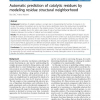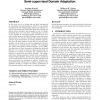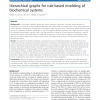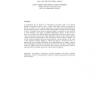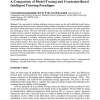199 search results - page 12 / 40 » An Intelligent System for Comparing Protein Structures |
BMCBI
2010
13 years 8 months ago
2010
Background: Prediction of catalytic residues is a major step in characterizing the function of enzymes. In its simpler formulation, the problem can be cast into a binary classific...
CIKM
2008
Springer
13 years 10 months ago
2008
Springer
In this work we try to bridge the gap often encountered by researchers who find themselves with few or no labeled examples from their desired target domain, yet still have access ...
BMCBI
2011
13 years 3 months ago
2011
Background: In rule-based modeling, graphs are used to represent molecules: a colored vertex represents a component of a molecule, a vertex attribute represents the internal state...
IJMI
2002
13 years 8 months ago
2002
A prerequisite for all higher level information extraction tasks is the identication of unknown names in text. Today, when large corpora can consist of billions of words, it is of...
AIEDU
2005
13 years 8 months ago
2005
Two approaches to building intelligent tutoring systems are the well-established model-tracing paradigm and the relatively newer constraint-based paradigm. Proponents of the constr...
